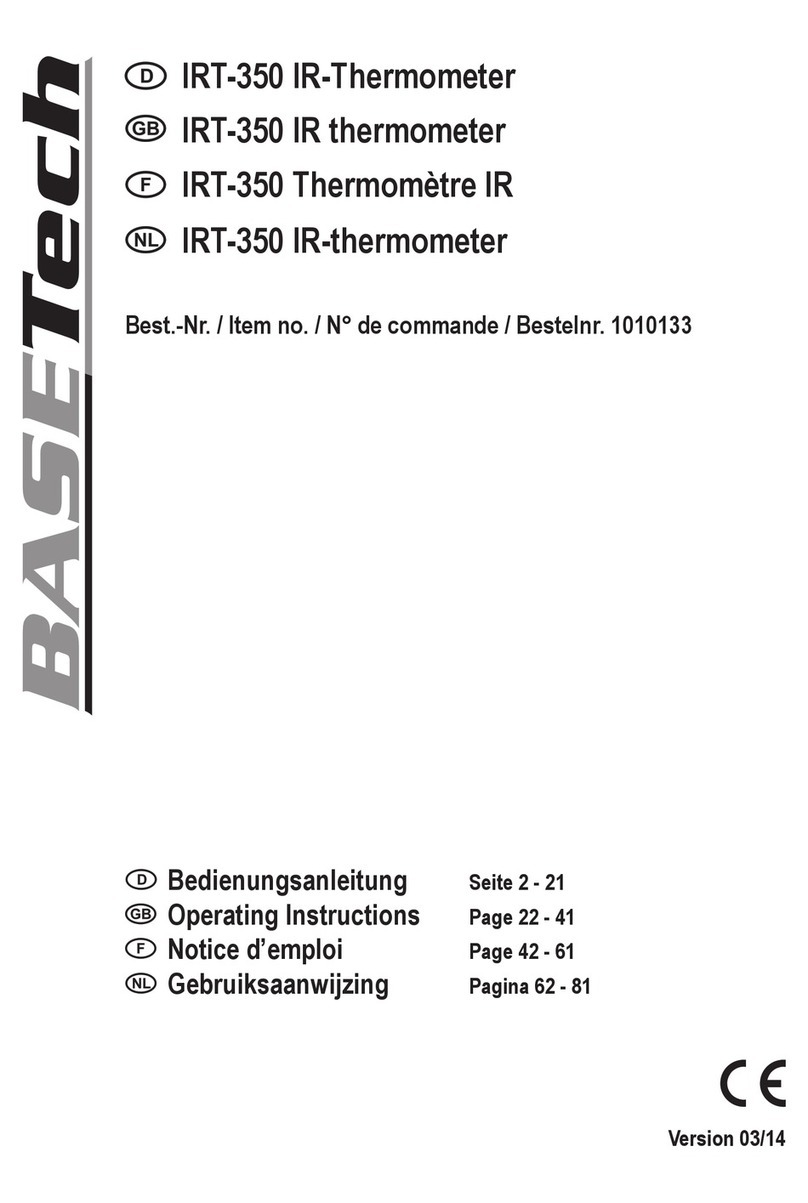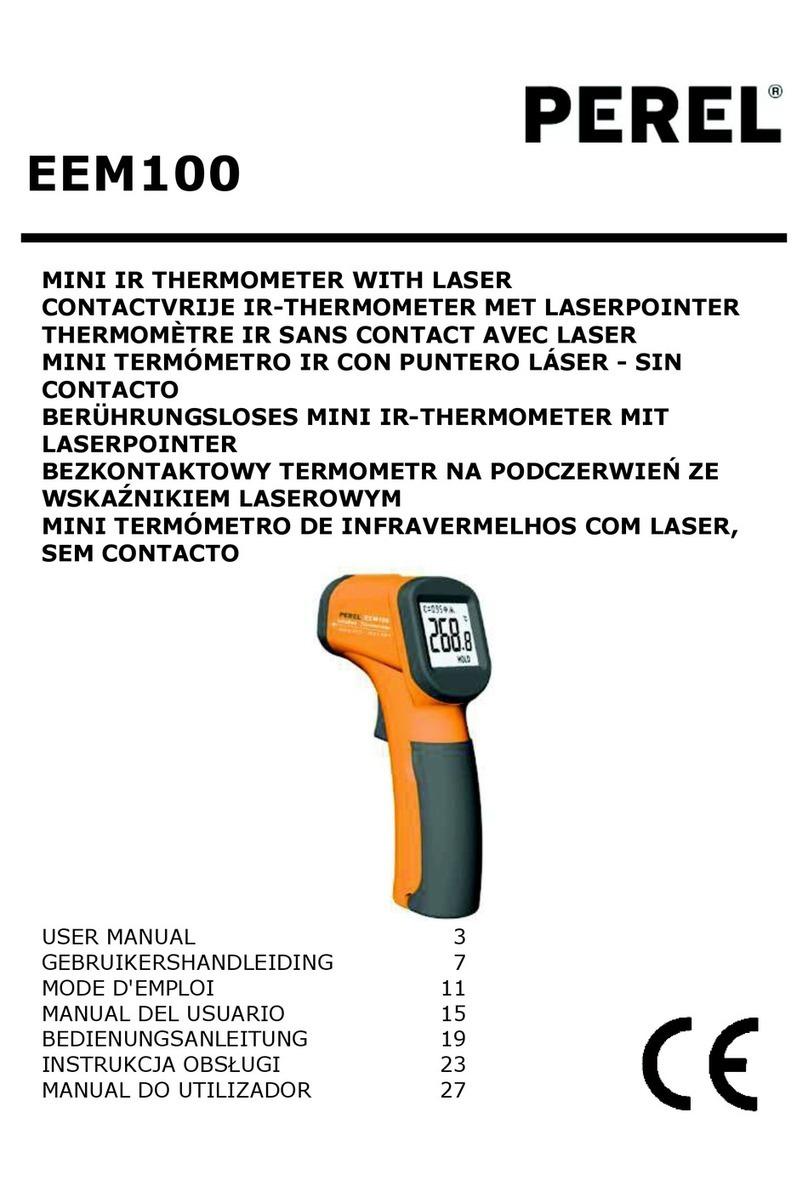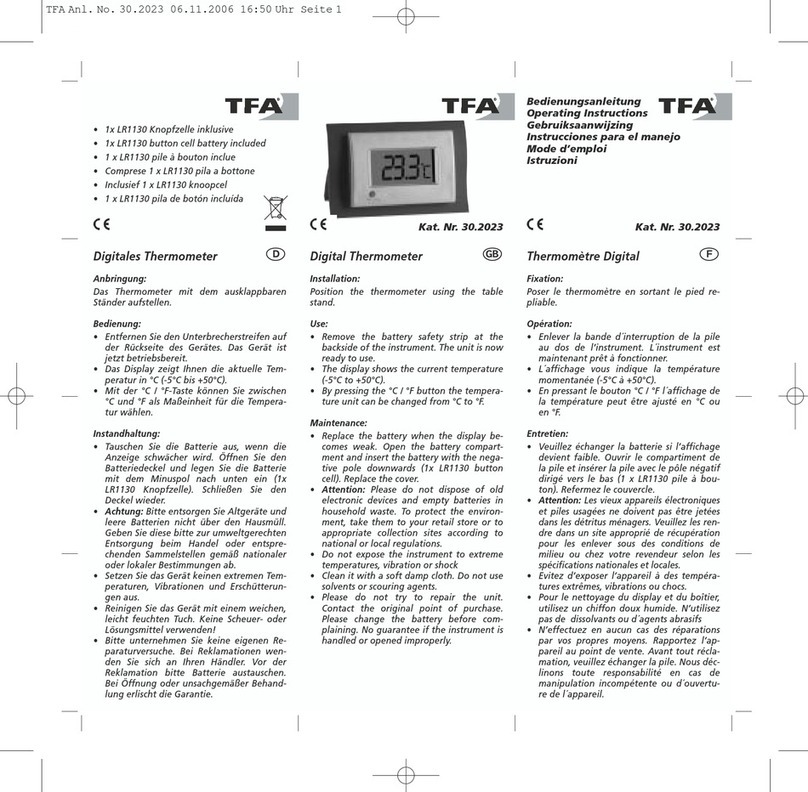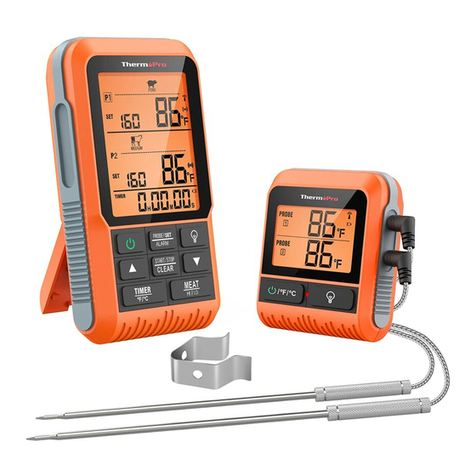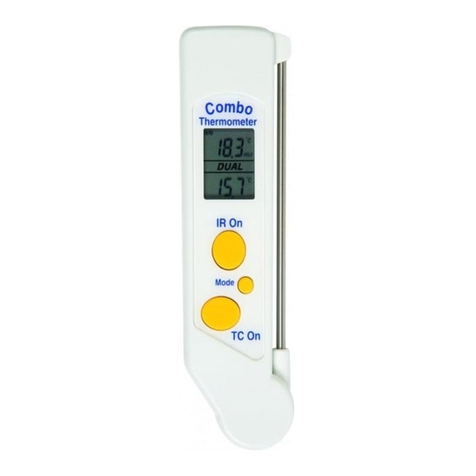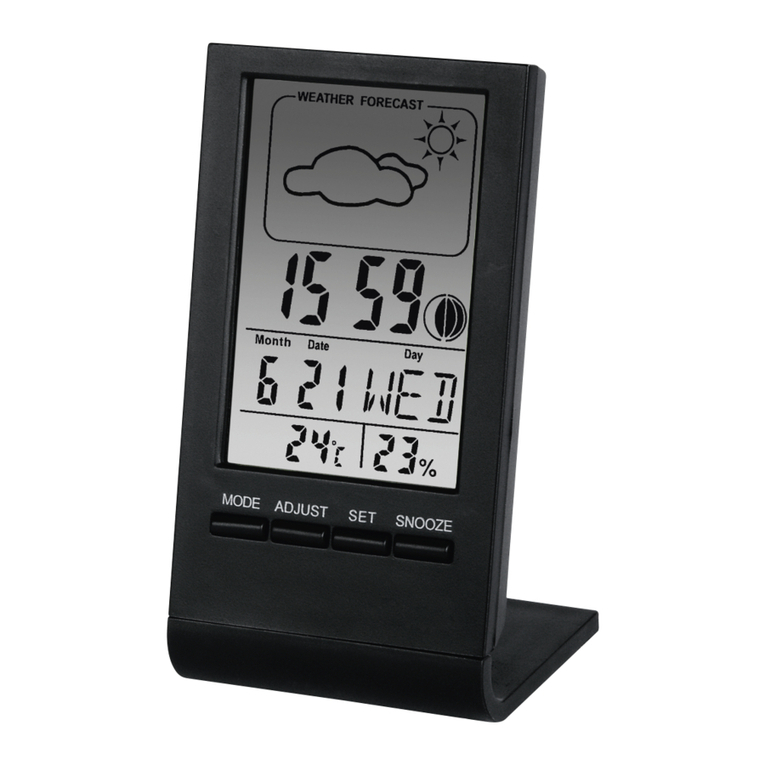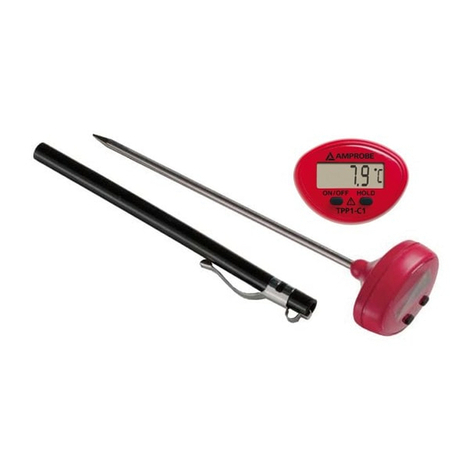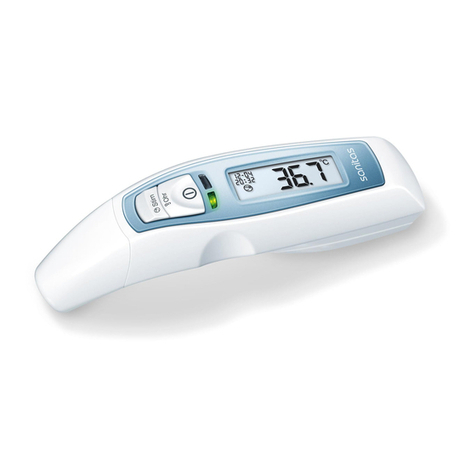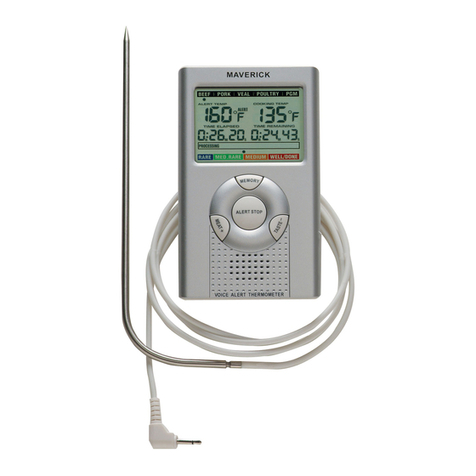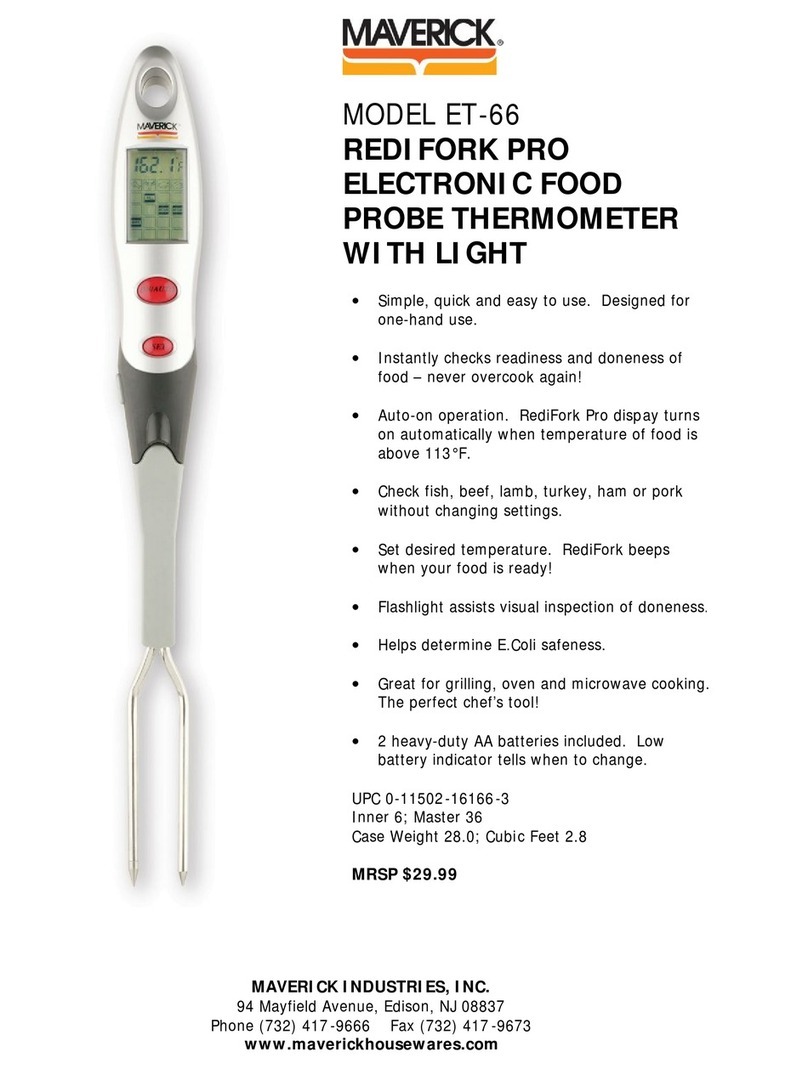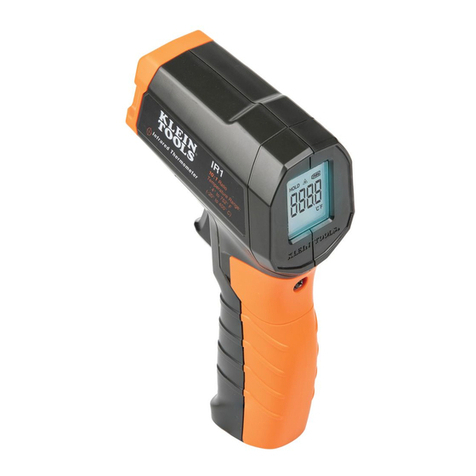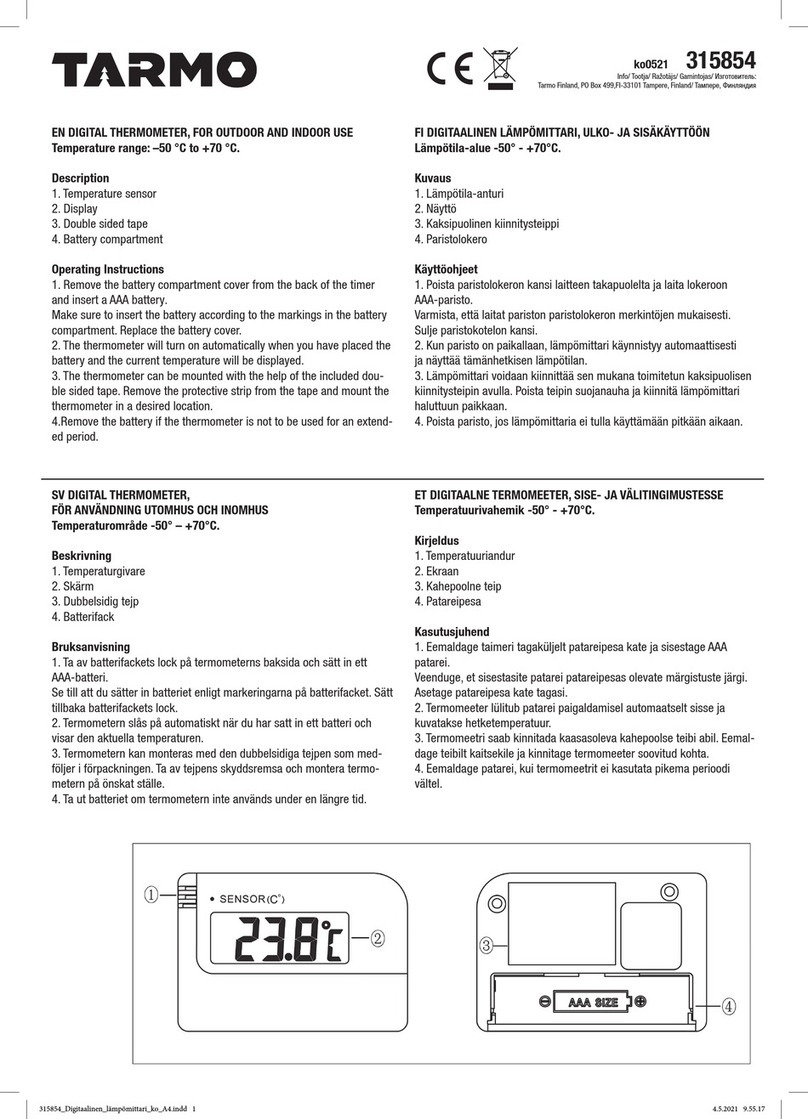No Touch Thermometers THD2FE User manual

THD2FE Non-contact Forehead Thermometer
Functions
Forehead temperature
The thermometer has been designed for home
use. It’s
not meant to replace a visit to the
doctor. Please also remember to compare the measurement result to your regular body
temperature. Please consult with doctor if you have health concerns.
Please see the “Use of the thermometer” section to learn how to measure the body
temperature.
Surface temperature
The surface mode shows the actual and unadjusted surface temperature which is different from
the body temperature. It can help you monitor if the object temperature is suitable for the baby
or patient, for example the baby’s milk.
Please see the “Use of the thermometer” section to learn how to measure the object
temperature.
Fever indication If the thermometer detects a temperature ≧37.5°C (or 99.5°F) under forehead mode, three
short beep sound will follow one long beep sound to warn the user for potential fever.
Memory locations There are total 25 sets of measurement condition for body temperature.
When power on, press the “ON/MEM” button to see the temperature records with icon.
°C / °F switch
In “Power Of
f
” mode, press and hold the “START” button, then press the “ON/MEM”
button for
3 seconds, icon “°C” will be switched to icon “°F”. You can also use the same process to
change the LCD display from °F to °C.
NOTE: Memory clear and Celsius/Fahrenheit switch are together. When you switch Celsius and
Fahrenheit, the Memory will be cleared.
Mute mode
The device setting with buzzer is on, you can set buzzer on/off under Mute mode.
When power on, press and hold the “ON/MEM” button for 3 seconds. The icon will flash on
the LCD screen and then release the “ON/MEM” button to set MUTE. Thus you will not hear
beep sounds. You can also use the same process to turn off the Mute function.
NOTE: If keep pressing "ON/MEN" button for 5 seconds after icon flashing, the device will
be power off WITHOUT setting Mute.
Use of the thermometer
Note: If there is any temperature difference between the places where the device is stored and where you are going to measure, subject and the device should
stay in the same room for at least 15 minutes before measurement.
1. Always make sure the probe lens is clean without any damage and the forehead is clean.
Warning: Choking from swallowing small parts and batteries by children or pets is possible, please keep small parts and batteries at places where
children and pets can’t reach.
2. Power on:
Press the “ON/MEM” button (see figure 1).
Figure 1
Intended use: The infrared forehead thermometer can measure the infrared heat generated by
central forehead and surrounding tissues to reflect patient’s body temperature
accurately.
Intended operator:
A
t least 11 years old (5 years intensive reading experience), no maximum.
Specifications Temperature measurement
range:
Forehead mode: 34~42.2°C (93.2~108°F)
Surface mode: -22~80°C (-7.6~176°F)
Operating temperature range: 10~40°C (50~104°F), 15%~85% RH
Storage temperature range: It should be stored at room temperature between -20~+50°C ,
RH≦85%
Transportation temperature shall be less than 70°C, RH≦95%
Atmospheric pressure: 800~1013 hPa
Comply with ASTM E1965-98, EN ISO 80601-2-56, IEC/EN60601-1-2(EMC),
IEC/EN60601-1(Safety) standards, ISO10993, RoHS.
Accuracy:
Forehead mode: ±0.2 oC (0.4 oF) within 35~42°C (95~107.6°F),
±0.3 oC (0.5 oF) for other range.
Surface mode: ±0.3°C (0.5°F) within 22~42.2°C (71.6~108°F),
others ±4% or ±2°C (4°F) whichever is greater.
Fever indication, memory and °C/°F switch function
Battery: AAA x 2 pcs
Battery life: around 3,000 continuous readings.
Expected Service Life: 4 years
This thermometer converts the forehead temperature to display its “oral equivalent.”
(according to the result of the clinical evaluation to get the offset value)
E: Blue LED Backlight
Blue LED backlight will be automatically turned on after measurement, and automatically
turned off after 5 seconds.
Enclosure Rating: IP22
Dimensions: 158.0 x 48.0 x 40.2 mm
Weight: 100 grams including battery
The device should not submerge into any liquids and expose it to direct moisture.
There is no gender and age limitation for using the infrared thermometer.
This is not an AP or APG product.

Ref No.:032020
3. Measuring body temperature on the forehead:
Press the “ON/MEM” button to power on the device. Forehead mode is the default mode. You can see the icon on the screen
and hear two beep sounds (see figure 1). In this mode, you can hold the thermometer within 4 cm from the central forehead (Fig. 2) and press
the "START" button to get the forehead measurement. The time consuming for measurement might be 1 second. After each forehead
measurement, wait icon stop flashing to be ready for next measurement. Figure 2
Points for attention:
a. Forehead temperature is displayed in oral mode. This mode converts the forehead temperature to display its “oral-equivalent” value.
b. Before the measurement, the subject should stay in a stable environment for 5 minutes and avoid exercise, bath for 30mins.
c. Remember to keep the forehead area clean and away from sweat, cosmetics and scar while taking temperature.
d. The “Clinical Bias” is -1.4~-1.7°C.
e. The “Limits of Agreement” is 0.98.
f. The "Repeatability" is 0.20°C.
4. Measuring surface temperature:
4.1 After power on, press and hold the “ON/MEM” button, and press the “START” button one time for “Infrared thermometer” mode to see icon on your LCD
display. In this mode, you can get the target surface temperature.
4.2 When you press the “START” button, you will get the real time temperature immediately. If you press and hold the “START” button, the reading of measurement will
be continuously updated.
4.3 Applications include temperature measurements for water, milk, cloth, skin or other objects.
* Note: This mode shows the actual and unadjusted surface temperature which is different from the body temperature.
5. Power off:
5.1 Device will automatically shut off if left idle for more than 1 minute to extend battery life.
5.2 Manually power off the device by pressing the “ON/MEM” button.
Important Notes
Cleaning
And Storage
Please make sure the probe is clean to ensure
an accurate reading.
The probe lens is the most delicate part of the thermometer. Use with care when cleaning the probe lens to avoid damage.
a. Use alcohol swabs or cotton swabs moistened with 70%~75% alcohol to clean the probe lens.
b. Allow the probe to fully dry for at least 1 minute.
c. Keep the unit dry and away from any liquids and direct sunlight.
d.Storage temperature range: It should be stored at room temperature between -20~+50°C, RH≦85%
e. The Probe should not be submerged into liquids.
Holding the thermometer too long may cause a higher ambient temperature reading of the probe.
This could make the body temperature measurement lower than usual.
Battery replacement
When the “Low Battery” icon indicates the battery is low, the battery should be replaced immediately with AAA *2 pcs batteries.
1. Open the battery cover: Use the thumbs to push battery cover out. (See Figure 1)
2. Insert the new AAA *2 pcs batteries. (See Figure 2)
3. Replace the battery cover. (See Figure 3)
Trouble shooting:
Error Message Problem Solution
Error 5~9, the system is not functioning properly. Unload the batter
y
, wait for 1 minute and repower it. If the message
reappears, contact the retailer for service.
Measurement before device stabilization. Wait for “Er1” to disappear.
The ambient temperature is not within the range between 10oC and 40oC (50oF ~104oF).
A
llow the thermometer to rest in a room for at least 15
minutes at
room
temperature: 10oC and 40oC (50oF ~104oF).
(1) In forehead mode: Temperature taken is higher than +42.2oC (108°F)
(2) In surface mode: Temperature taken is higher than +80oC (176°F) Please select the target within specifications. If a malfunction still
exists, please contact the nearest retailer.
(1) In forehead mode: Temperature taken is lower than +34oC (93.2°F)
(2) In surface mode: Temperature taken is lower than –22oC (-7.6°F)
Device cannot be powered on to the ready stage. Change with a new battery.
Warranty:
Warranty: 12 months
Manufacture Date: as the serial number (please open the battery cover, it is shown on the inside of the device.)
Ex.SN:E512A000001, the first “E” is External, the second number “5” is the last number of manufacture year, the third and the fourth number “12” is the manufacture
month, the others is the serial number.
Note: The thermometer is calibrated at the time of manufacture. If you question calibration mode, the accuracy of temperature measurements or unexpected
events at any time, please contact the dealers or nearest service address.
Warning: No modification of this equipment is allowed.
Please read the instructions for use BF type applied part
Radiant Innovation Inc.
Http://www.radiantek.com.tw
Add: 1F, No.3, Industrial East 9th Road,
Science-Based Industrial Park, HsinChu, Taiwan 300.
Medical Technology Promedt Consulting GmbH
Add: Altenhofstrasse 80, D-66386 St. Ingbert,
Germany
Figure1 Figure2 Figure3
Sponsored By:
ASTS Enterprises (Aust) Pty Ltd
2/11 Evans Street, Burwood, VIC, 3125, Australia
Tel: (03) 9888 8771

Symbol Descriptions
The CE mark and Notified Body
Registration Numbers, the
requirement of Annex II from Medical
Device Directive 93/42/EEC are met.
Indicates this device is subject to the Waste
Electrical and Electronic
Equipment Directive in the European Union.
To protect the environment, dispose of
useless device at appropriate collection sites
according to national or local regulations.
Authorized
representative in the
European community
Caution Please read the instructions for use
Manufacturer
BF type applied part
Battery Recycling
Paper Recycling
IP22 Classification for water ingress and
particulate matter. Stand-by
Manufacturer’s declaration-electromagnetic emissions
The THD2Fxy series is intended for use in the electromagnetic environment (for home healthcare) specified below.The customer or the user of the
THD2Fxy series should assure that it is used in such an environment.
Emissions test Compliance Electromagnetic environment – guidance
(for home healthcare environment)
RF emissions
CISPR 11 Group 1 The THD2Fxy series uses RF energy only for its internal function. Therefore, its RF emissions
are very low and are not likely to cause any interference in nearby electronic equipment.
RF emissions
CISPR 11 Class B
The THD2Fxy series is suitable for use in all establishments, including domestic establishments
and those directly connected to the public low-voltage power supply network that supplies
buildings used for domestic purposes.
Manufacturer’s declaration – electromagnetic immunity
The THD2Fxy series is intended for use in the electromagnetic environment (for home healthcare) specified below. The customer or the user of the
THD2Fxy series should assure that it is used in such an environment.
Immunity test IEC 60601 test level Compliance level Electromagnetic environment – guidance
(for home healthcare environment)
Electrostatic discharge(ESD)
IEC 61000-4-2
Contact:±8 kV
Air±2 kV,±4 kV,±8
kV,±15 kV
Contact:±8 kV
Air±2 kV,±4 kV,±8
kV,±15 Kv
Floors should be wood, concrete or ceramic tile. If floors are covered
with synthetic material, the relative humidity should be at least 30%
Power frequency(50, 60 Hz)
magnetic field IEC 61000-4-8
30 A/m
50 Hz or 60 Hz
30 A/m
50 Hz and 60 Hz
The THD2Fxy series power frequency magnetic fields should be at
levels characteristic of a typical location in a typical home healthcare
environment.
Manufacturer’s declaration – electromagnetic immunity
The THD2Fxy series is intended for use in the electromagnetic environment (for home healthcare) specified below. The customer or the user of the
THD2Fxy series should assure that it is used in such an environment.
Immunity test IEC 60601 test level Compliance
level
Electromagnetic environment – guidance
(for home healthcare environment)
Radiated RF
IEC 61000-4-3
10 V/m
80 MHz – 2,7 GHz
80 % AM at 1 kHz
10 V/m
80 MHz – 2,7
GHz
80 % AM at 1
kHz
Recommended separation distance:
d = 1,2
d = 1,2 80MHz to 800 MHz
d = 2,3 800MHz to 2,7 GHz
Where P is the maximum output power rating of the transmitter in watts (W) according to
the transmitter manufacturer and d is the recommended separation distance in metres
(m).
Field strengths from fixed RF transmitters, as determined by an electromagnetic site
survey, ashould be less than the compliance level in each frequency range.b
Interference may occur in the vicinity of equipment marked with the
following symbol:
NOTE1 At 80 MHz and 800 MHz, the higher frequency range applies.
NOTE2 These guidelines may not apply in all situations. Electromagnetic propagation is affected by absorption and reflection from structures, objects
and people.

Field strengths from fixed transmitters, such as base stations for radio (cellular/cordless) telephones and land mobile radios, amateur radio, AM and FM
radio broadcast and TV broadcast cannot be predicted theoretically with accuracy. To assess the electromagnetic environment due to fixed RF
transmitters, an electromagnetic site survey should be considered. If the measured field strength in the location in which the THD2Fxy series is used
exceeds the applicable RF compliance level above, the THD2Fxy series should be observed to verify normal operation. If abnormal performance is
observed, additional measures may be necessary, such as re-orienting or relocating the THD2Fxy series.
Recommended separation distances between
portable and mobile RF communications equipment and the THD2Fxy series
The THD2Fxy series is intended for use in an electromagnetic environment (for home healthcare) in which radiated RF disturbances are controlled. The
customer or the user of the THD2Fxy series can help prevent electromagnetic interference by maintaining a minimum distance between portable and
mobile RF communications equipment (transmitters) and the THD2Fxy series as recommended below, according to the maximum output power of the
communications equipment.
Rated maximum output power of
transmitter
W
Separation distance according to frequency of transmitter
m
150 kHz to 80 MHz
d = 1,2
80 MHz to 800 MHz
d = 1,2
800 MHz to 2,7 GHz
d = 2,3
0,01 N/A 0,12 0,23
0,1 N/A 0,38 0,73
1 N/A 1,2 2,3
10 N/A 3,8 7,3
100 N/A 12 23
For transmitters rated at a maximum output power not listed above, the recommended separation distance d in meters (m) can be estimated using the equation
applicable to the frequency of the transmitter, where P is the maximum output power rating of the transmitter in watts (W) according to the transmitter manufacturer.
NOTE 1 At 80 MHz and 800 MHz, the separation distance for the higher frequency range applies.
NOTE 2 These guidelines may not apply in all situations. Electromagnetic propagation is affected by absorption and reflection from structures, objects and people.
Manufacturer’s declaration-electromagnetic immunity
Test specifications for ENCLOSURE PORT IMMUNITY to RF wireless communications equipment
The THD2Fxy series is intended for use in the electromagnetic environment (for home healthcare) specified below.The customer or the user of the THD2Fxy
series should assure that it is used in such an environment.
Test frequency
(MHz)
Band a)
(MHz) Service a) Modulation
b) Maximum power
(W)
Distance
(m)
IMMUNITY TEST
LEVEL
(V/m)
Compliance LEVEL
(V/m)
(for home healthcare)
385 380–390 TETRA 400
Pulse
modulation b)
18 Hz
1,8 0,3 27 27
450 430–470 GMRS 460,
FRS 460
FM c)
±5 kHz deviation
1 kHz sine
2 0,3 28 28
710
704–787 LTE Band 13,17
Pulse
modulation b)
217 Hz
0,2 0,3 9 9
745
780
810
800–960
GSM 800/900,
TETRA 800,
iDEN 820,
CDMA 850,
LTE Band 5
Pulse
modulation b)
18 Hz
2 0,3 28 28
870
930
1720
1700–
1990
GSM 1800;
CDMA 1900;
GSM 1900;
DECT;
LTE Band 1, 3,
4, 25; UMTS
Pulse
modulation b)
217 Hz
2 0,3 28 28
1845
1970
2450 2400–
2570
Bluetooth,
WLAN,
802.11 b/g/n,
RFID 2450,
LTE Band 7
Pulse
modulation b)
217 Hz
2 0,3 28 28
5240
5100–
5800
WLAN 802.11
a/n
Pulse
modulation b)
217 Hz
0,2 0,3 9 9
5500
5785
NOTE If necessary to achieve the IMMUNITY TEST LEVEL, the distance between the transmitting antenna and the ME EQUIPMENT or ME
SYSTEM may be reduced to 1 m. The 1 m test distance is permitted by IEC 61000-4-3.
a) For some services, only the uplink frequencies are included.
b) The carrier shall be modulated using a 50 % duty cycle square wave signal.
c) As an alternative to FM modulation, 50 % pulse modulation at 18 Hz may be used because while it does not represent actual modulation,
it would be worst case.
Table of contents

